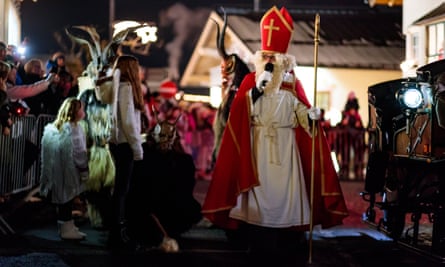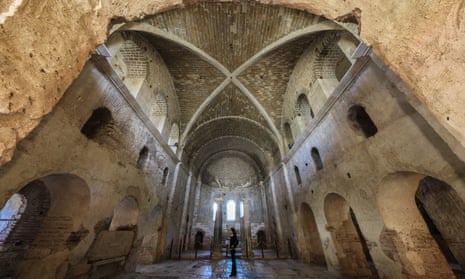The real hometown of Santa Claus is nothing like the North Pole. It is a two-hour drive from the city of Antalya, along a coastal road in Turkey nestled between the sparkling blue of the Mediterranean and, in the distance, the imposing Taurus mountains.
There, in the town of Demre – called Myra in antiquity – lived St Nicholas, celebrated by Christians as a gift-giver.
In the sixth century, a church was built here in his name. Its austere interior is punctuated by exquisite frescoes, and twin marble pillars still stand where the altar once was, gleaming in the sunlight flooding through its windows. A statue of a bearded and hooded St Nicholas surrounded by children stands near the entrance of the monastery complex.
But it is not what lies above the ground that has sparked renewed interest in the life of the saint whose generosity gave rise to Santa Claus. Since claims emerged of a newly discovered chamber beneath the church, an archaeological debate has raised questions on the ultimate resting place of his remains.

Theologians say the most logical possibility is that his body was smuggled to Italy in the 11th century. But Turkish officials believe his remains may lie beneath the Byzantine church.
“There is something under there and we don’t know what it is,” said Cemil Karabayram, the head of the monuments authority in Antalya. “St Nicholas lived and died here, and he might still be buried here.”
Turkish archaeologists claim the remains that were smuggled out to Bari and Venice belonged to an anonymous priest, while the real body stayed behind in a hidden chamber.
Antalya is Turkey’s most popular tourist destination, attracting more than 9.25 million people in 2017. Russian tourists, who made up nearly 15% of visitors this year, often visit the St Nicholas church, which was first restored by Tsar Nicholas I. Turkey is keen to promote further tourism to the area, particularly in off-season months.
That vested interest has provoked doubt among those who say that the evidence the bones in Bari are authentic remains the strongest possibility.

“I remain sceptical about the new claims to the real tomb,” said Adam C English, the chair of the department of Christian studies at Campbell University, and author of The Saint Who Would be Santa Claus: The True Life and Trials of Nicholas of Myra.
“We have yet to see what will be found under the floor of the church, but they would need to find some kind of incontrovertible evidence to make a serious challenge to the established and well documented tradition.”
That tradition is based on accounts of a raid by sailors from the city of Bari. According to Nicephorus, a man apparently commissioned by religious and city officials in Bari to write the first account of efforts to reclaim the body, the sailors removed his remains from the church after the pope, during a visit to the city, had a vision of St Nicholas asking to be moved from his resting place.
Turkish officials support a rival claim that the monks tricked their captors into taking the body of another priest. “The priests that took over died and were buried here and there are many graves,” said Karabayram. “The original bones were protected, and the Bari ones belong to another priest.”

English said that such a deception by the monks would not have remained secret for very long. “The tomb had been an international pilgrimage site for 700 years by the time the Barians arrived in 1087. The church had been built to house the tomb, so it would have been well marked and obvious to anyone visiting.“So, the monks deceived both the Barians and the Venetians, and everyone else? And if they did, why did they not announce later that they still had the bones and still welcomed pilgrims to see them? Or, why are there not substantial sources that give this other narrative?”
The account that his remains were moved to Italy was strengthened by researchers at Oxford University who recently dated a bone fragment allegedly belonging to St Nicholas to the 4th century, around the time of his death.
The mystery is not about to be settled soon. Turkish authorities do not want to damage the church or the mosaics on its floor. If approval is granted for a dig into the chamber, it will only take place in a garden outside by the courtyard, and may be years in the making.
